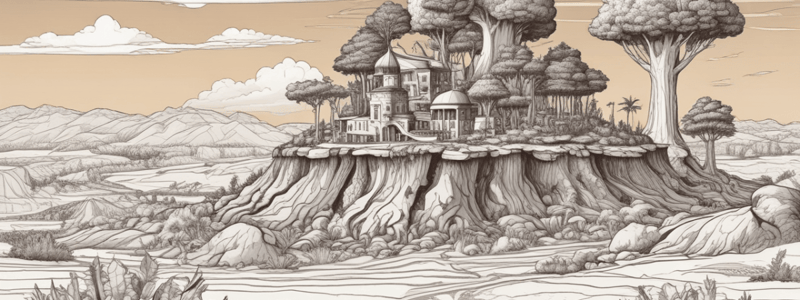Podcast
Questions and Answers
What is a distinct characteristic of columnar soil aggregates?
What is a distinct characteristic of columnar soil aggregates?
- Vertical dimensions (correct)
- Loose and porous structure
- Horizontal compacted layering
- Fast drainage of water
Which type of soil is known for providing the slowest drainage for water?
Which type of soil is known for providing the slowest drainage for water?
- Columnar soil (correct)
- Platy soil
- Clay soil
- Silt soil
What is the primary importance of soil in an ecosystem like a forest?
What is the primary importance of soil in an ecosystem like a forest?
- Provides physical structure
- Essential for water filtration
- Supports wildlife habitat
- Fundamental piece for survival (correct)
Why is studying soil and its micro-ecosystems important?
Why is studying soil and its micro-ecosystems important?
What is a significant use of soil in the construction industry?
What is a significant use of soil in the construction industry?
What type of soil is often used in construction due to its ability to hold shape?
What type of soil is often used in construction due to its ability to hold shape?
Why are clay and silt soils commonly used in house construction?
Why are clay and silt soils commonly used in house construction?
What is a common use of soil in agriculture?
What is a common use of soil in agriculture?
What is the significance of understanding the soil beneath a construction site?
What is the significance of understanding the soil beneath a construction site?
What is the primary reason why farmers maintain good soil conditions?
What is the primary reason why farmers maintain good soil conditions?
Flashcards are hidden until you start studying
Study Notes
What is Soil?
- Soil is a medium that consists of a mixture of sediment, minerals, organic matter, air, gases, liquids, organisms, and microorganisms.
- It provides the fundamental ecosystem and essentials for plant life and all life.
Soil Functions
- Provides space and medium for plants to grow.
- Provides water storage and water purification.
- Provides a home for many organisms, especially microorganisms.
- Participates in all major biogeochemical cycles (e.g., phosphorous, nitrogen, and carbon cycles).
Soil Composition
- Varies in gas content due to microorganisms, decomposing organic matter, and plants.
- Different conditions and amounts of organic matter in soils from different regions affect gas content.
- Space between particles of sediment determines how easily gases and liquids flow through it.
Soil Types
- Four main types: sand, silt, clay, and loam.
- Each type provides different circumstances and microclimates (e.g., water content, permeability, and aeration).
Soil Structure and Development
- Develops and accumulates from basic components through multiple processes (e.g., sediment weathering, erosion, organic matter introduction, decomposition, and water introduction).
- Not all soils are the same, and base sediments determine the type of ecosystem.
Soil Layers
- Soil profile consists of many layers of sediments beneath a top layer of soil, each layer being a different soil horizon.
- Top layer's sediment matrix can be composed of sand, silt, clay, or loam, while underlying layers consist of compacted layers of sediments before reaching bedrock.
Sand
- Sediment with tiny weathered rock particles between 62 microns (very fine) and 2 millimeters (very coarse) in size.
- Coarsest, largest, and loosest of soil classifications.
- Provides easy drainage for water, but is not very nutritious for growing plants.
Silt
- Sediment with particles between 4 and 62 microns in size.
- Holds onto water more and longer than sand, allowing for nutrients to remain.
- Very common in swampy and muddy conditions.
Clay
- Sediment with particles less than 4 microns in size.
- Fine-grained silt that holds onto water well, but lacks drainage and aeration.
- Often found deep below layers of topsoil.
Loam
- Combination of sand, silt, and clay.
- Provides the best of both worlds for plant life (drainage, water storage, and aeration).
- Commonly used for farming and found all around the world.
Differences in Structure and Arrangement
- Soil varies in particle size, shape, and arrangement (e.g., granular, platy, and columnar structures).
- Granular soil provides good drainage and aeration.
- Platy soil has horizontal layering, decreasing drainage.
- Columnar soil is dense and compacted, with slow drainage.
Uses of Soil
- Fundamental for ecosystem survival (e.g., forest ecosystems).
- Important for agricultural industry (food and fiber production).
- Used as a building material (e.g., concrete, construction sites).
- Understanding soil is important for maintaining proper soil conditions for future generations.
Studying That Suits You
Use AI to generate personalized quizzes and flashcards to suit your learning preferences.




